Characteristics and Energy Distribution of Blast-Induced Ground Vibration in Deep-Hole Blasting
Abstract
:1. Introduction
2. Increasing Extreme Value of Blast-Induced Ground Vibration Signal
2.1. Incremental Extremum Extraction
2.1.1. Threshold Function
2.1.2. Incremental Extremum Extraction Algorithm
3. Analysis of Particle Velocity Extremum
3.1. Site Conditions and Blasting Parameters
3.2. Ground Vibration Monitoring
3.3. Surface Particle Velocity Vector Analysis
4. Analysis of Cumulative Energy of Blast-Induced Ground Vibration
5. Conclusions
- (1)
- Based on the characteristics of open-pit deep-hole blasting and vibration signals of the same horizontal step, an increasing extremum extraction method was proposed which can obtain multiple particle velocity extrema corresponding to different blast center distances from a set of signals. This method forms the basis for statistics and analysis of the vibration signal.
- (2)
- The particle velocity was linearly proportional to the distance from the blasting center to the monitoring point when multiple rows of explosives in deep holes were detonated under the condition of a certain mass of charge in a single hole. Furthermore, the linear law of increasing and decreasing velocity was inconsistent, and particle velocity in the increasing stage was higher than that in the decreasing stage.
- (3)
- The method for assessing the vector of extreme particle velocity was proposed to study the relationship between the distance from the blast center to the monitoring site and particle velocity. The numerical value and vector relationship were combined for analysis based on the characteristics of the vector describing the spatial position relationship of physical quantities. The extreme particle velocity and the angle with the ground plane were expressed and statistically analyzed, which was distinct from the traditional digital signal processing method to explain the spatial dynamic problem. The kinetic energy in the vertical direction accumulates at a greater rate in positions closer to the epicenter, and the increase in kinetic energy at more distant positions is very similar to that in the horizontal (X and Y) direction.
Author Contributions
Funding
Institutional Review Board Statement
Informed Consent Statement
Data Availability Statement
Conflicts of Interest
References
- Zhou, J.; Qiu, Y.; Khandelwal, M.; Zhu, S.; Zhang, X. Developing a Hybrid Model of Jaya Algorithm-Based Extreme Gradient Boosting Machine to Estimate Blast-Induced Ground Vibrations. Int. J. Rock Mech. Min. Sci. 2021, 145, 104856. [Google Scholar] [CrossRef]
- Wang, K.; Qian, X.; Liu, Z. Experimental and Numerical Investigations on Predictor Equations for Determining Parameters of Blasting-Vibration on Underground Gas Pipe Networks. Process Saf. Environ. Prot. 2020, 133, 315–331. [Google Scholar] [CrossRef]
- Tian, X.; Song, Z.; Wang, J. Study on the Propagation Law of Tunnel Blasting Vibration in Stratum and Blasting Vibration Reduction Technology. Soil Dyn. Earthq. Eng. 2019, 126, 105813. [Google Scholar] [CrossRef]
- Kumar, S.; Chandra Dutta, S.; Goswami, K.; Mandal, P. Vulnerability Assessment of Building Structures Due to Underground Blasts Using ANN and Non-Linear Dynamic Analysis. J. Build. Eng. 2021, 44, 102674. [Google Scholar] [CrossRef]
- Jiang, N.; Zhou, C.; Lu, S.; Zhang, Z. Propagation and Prediction of Blasting Vibration on Slope in an Open Pit during Underground Mining. Tunn. Undergr. Space Technol. 2017, 70, 409–421. [Google Scholar] [CrossRef]
- Aldas, G.G.U.; Ecevitoglu, B. Waveform Analysis in Mitigation of Blast-Induced Vibrations. J. Appl. Geophys. 2008, 66, 25–30. [Google Scholar] [CrossRef]
- Gou, Y.; Shi, X.; Yu, Z.; Huo, X.; Qiu, X. Evaluation of Underground Blast-Induced Ground Motions through near-Surface Low-Velocity Geological Layers. J. Rock Mech. Geotech. Eng. 2022, 15, 600–617. [Google Scholar] [CrossRef]
- Chen, S.; Wu, J.; Zhang, Z. Blasting Vibration Characteristics and PPV Calculation Formula Considering Cylindrical Charge Length. Environ. Earth Sci. 2017, 76, 674. [Google Scholar] [CrossRef]
- Ainalis, D.; Ducarne, L.; Kaufmann, O.; Tshibangu, J.-P.; Verlinden, O.; Kouroussis, G. Improved Analysis of Ground Vibrations Produced by Man-Made Sources. Sci. Total Environ. 2018, 616, 517–530. [Google Scholar] [CrossRef]
- Zhou, J.; Asteris, P.G.; Armaghani, D.J.; Pham, B.T. Prediction of Ground Vibration Induced by Blasting Operations through the Use of the Bayesian Network and Random Forest Models. Soil Dyn. Earthq. Eng. 2020, 139, 106390. [Google Scholar] [CrossRef]
- Matidza, M.I.; Jianhua, Z.; Gang, H.; Mwangi, A.D. Assessment of Blast-Induced Ground Vibration at Jinduicheng Molybdenum Open Pit Mine. Nat. Resour. Res. 2020, 29, 831–841. [Google Scholar] [CrossRef]
- Roy, M.P.; Mishra, A.K.; Agrawal, H.; Singh, P.K. Blast Vibration Dependence on Total Explosives Weight in Open-Pit Blasting. Arab. J. Geosci. 2020, 13, 531. [Google Scholar] [CrossRef]
- Yan, B.; Liu, M.; Meng, Q.; Li, Y.; Deng, S.; Liu, T. Study on the Vibration Variation of Rock Slope Based on Numerical Simulation and Fitting Analysis. Appl. Sci. 2022, 12, 4208. [Google Scholar] [CrossRef]
- Yan, Y.; Hou, X.; Fei, H. Review of predicting the blast-induced ground vibrations to reduce impacts on ambient urban communities. J. Clean. Prod. 2020, 260, 121135. [Google Scholar] [CrossRef]
- Yu, Z.; Shi, X.; Miao, X.; Zhou, J.; Khandelwal, M.; Chen, X.; Qiu, Y. Intelligent Modeling of Blast-Induced Rock Movement Prediction Using Dimensional Analysis and Optimized Artificial Neural Network Technique. Int. J. Rock Mech. Min. Sci. 2021, 143, 104794. [Google Scholar] [CrossRef]
- Nguyen, H.; Bui, X.N.; Tran, Q.H.; Nguyen, D.A.; Hoa, L.T.T.; Le, Q.T.; Giang, L.T.H. Predicting Blast-Induced Ground Vibration in Open-Pit Mines Using Different Nature-Inspired Optimization Algorithms and Deep Neural Network. Nat. Resour. Res. 2021, 30, 4695–4717. [Google Scholar] [CrossRef]
- Bui, X.N.; Nguyen, H.; Tran, Q.H.; Nguyen, D.A.; Bui, H.B. Predicting Blast-Induced Ground Vibration in Quarries Using Adaptive Fuzzy Inference Neural Network and Moth–Flame Optimization. Nat. Resour. Res. 2021, 30, 4719–4734. [Google Scholar] [CrossRef]
- Temeng, V.A.; Arthur, C.K.; Ziggah, Y.Y. Suitability Assessment of Different Vector Machine Regression Techniques for Blast-Induced Ground Vibration Prediction in Ghana. Model. Earth Syst. Environ. 2022, 8, 897–909. [Google Scholar] [CrossRef]
- Verma, A.K.; Singh, T.N. Comparative Study of Cognitive Systems for Ground Vibration Measurements. Neural Comput. Appl. 2013, 22, 341–350. [Google Scholar] [CrossRef]
- Hasanipanah, M.; Monjezi, M.; Shahnazar, A.; Jahed Armaghani, D.; Farazmand, A. Feasibility of Indirect Determination of Blast Induced Ground Vibration Based on Support Vector Machine. Measurement 2015, 75, 289–297. [Google Scholar] [CrossRef]
- Hasanipanah, M.; Faradonbeh, R.S.; Amnieh, H.B.; Armaghani, D.J.; Monjezi, M. Forecasting Blast-Induced Ground Vibration Developing a CART Model. Eng. Comput. 2017, 33, 307–316. [Google Scholar] [CrossRef]
- Khandelwal, M.; Armaghani, D.J.; Faradonbeh, R.S.; Yellishetty, M.; Majid, M.Z.A.; Monjezi, M. Classification and Regression Tree Technique in Estimating Peak Particle Velocity Caused by Blasting. Eng. Comput. 2017, 33, 45–53. [Google Scholar] [CrossRef]
- Gao, Q.; Lu, W.; Hu, Y.; Yang, Z.; Yan, P.; Chen, M. An evaluation of numerical approaches for S-wave component simulation in rock blasting. J. Rock Mech. Geotech. Eng. 2017, 9, 830–842. [Google Scholar] [CrossRef]


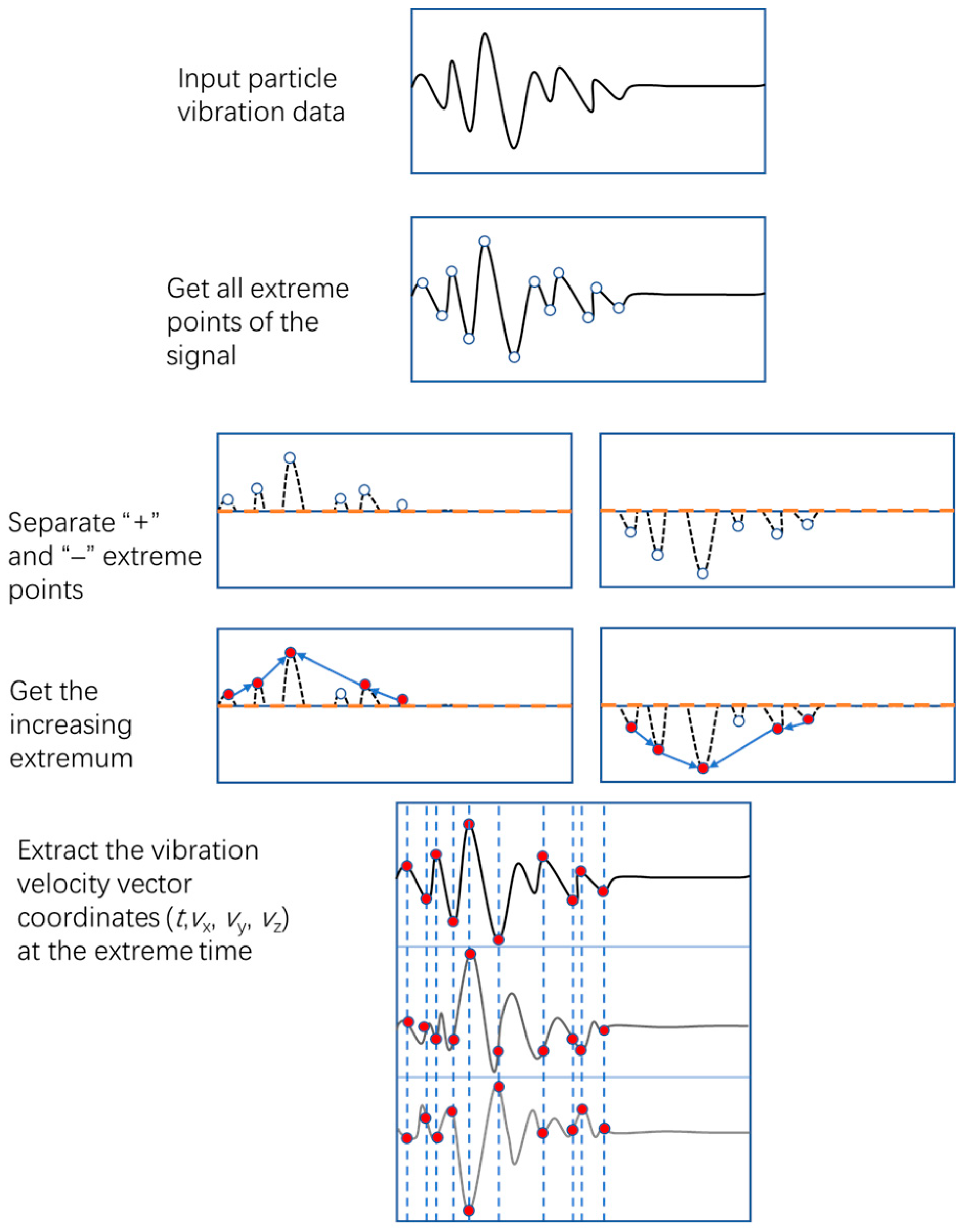
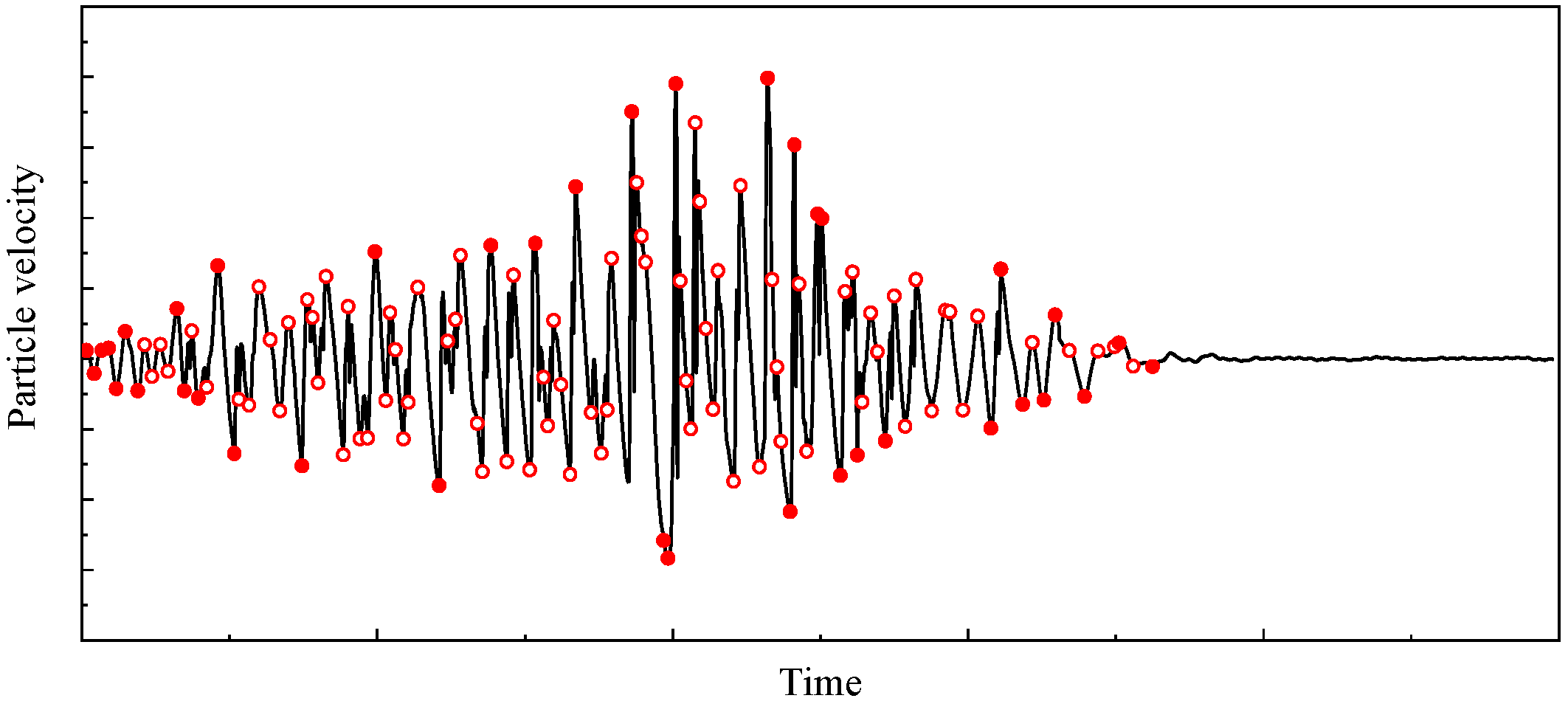
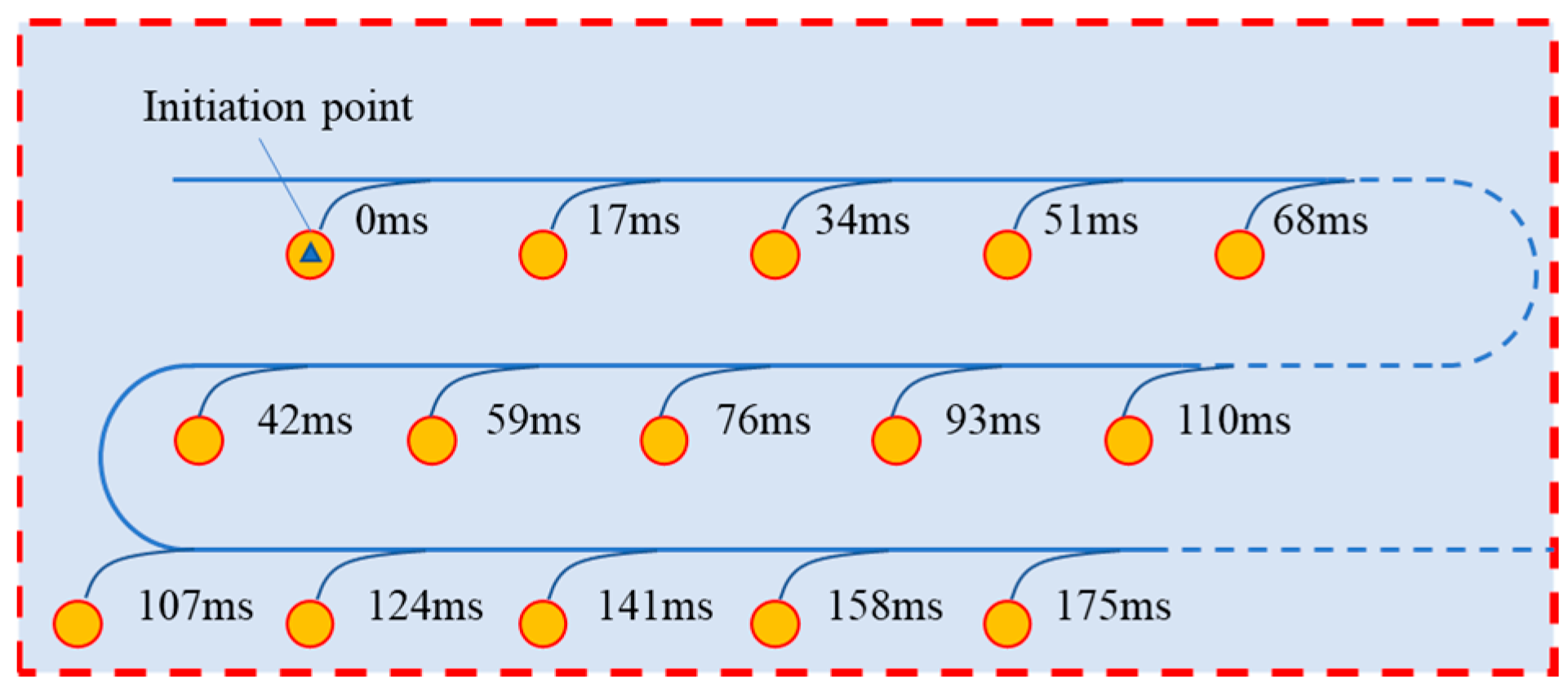

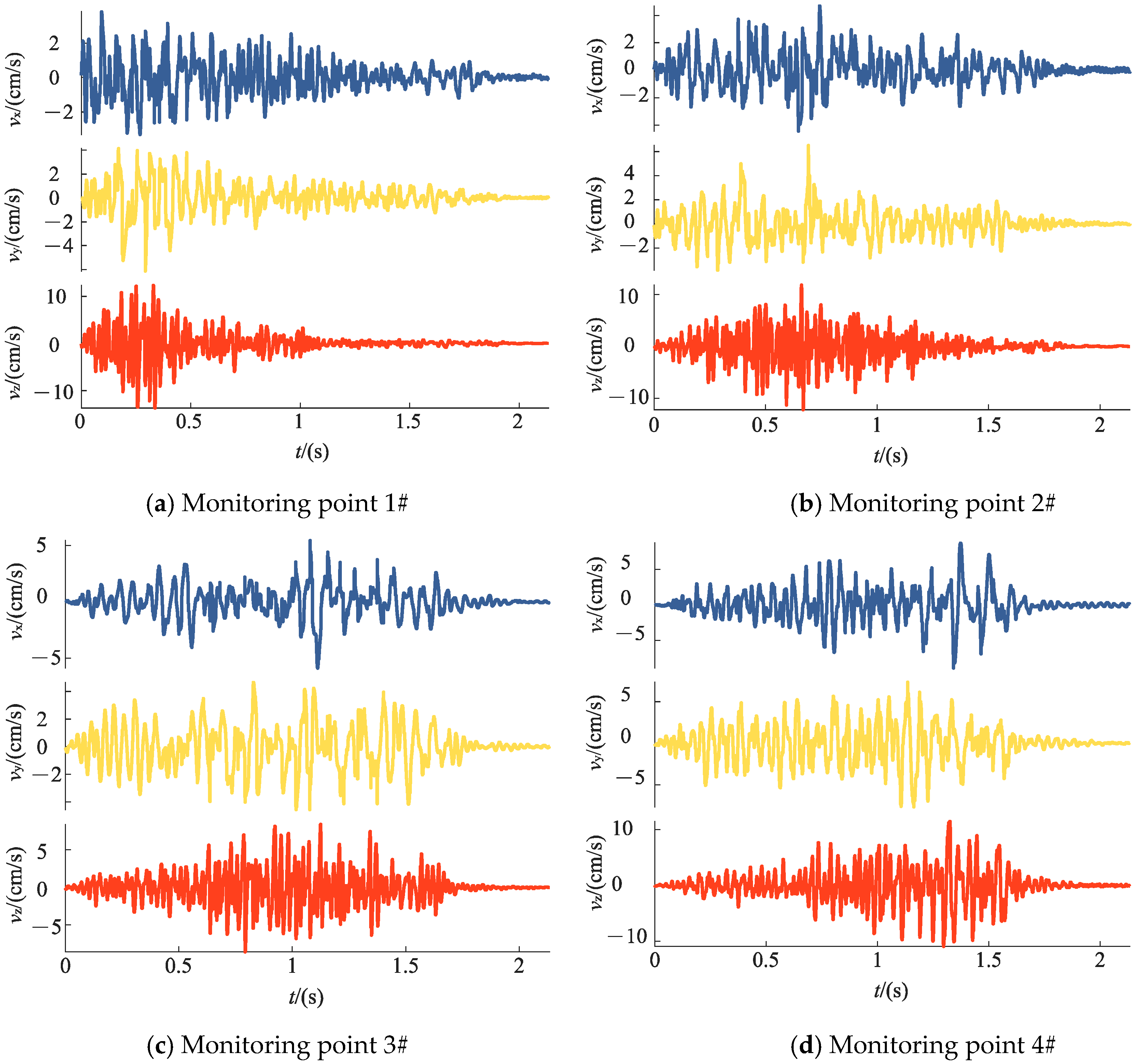

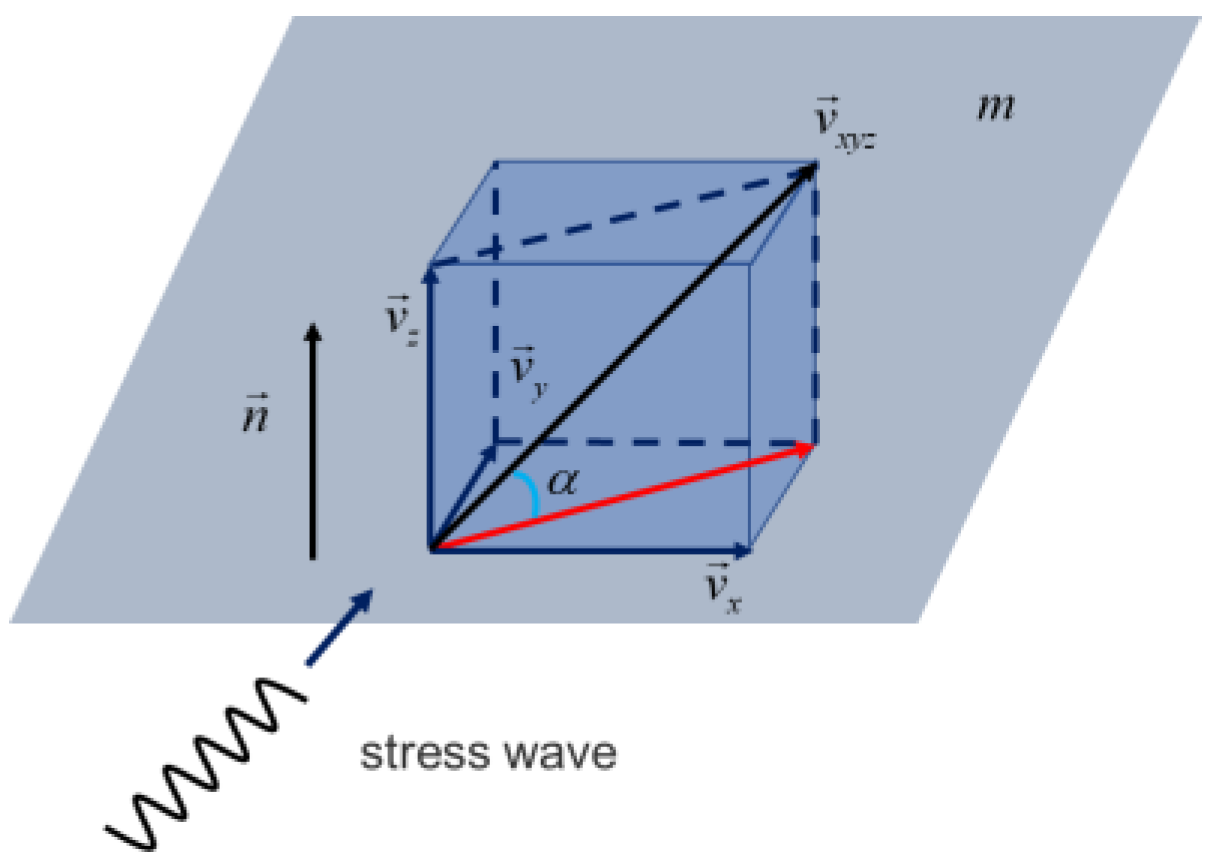

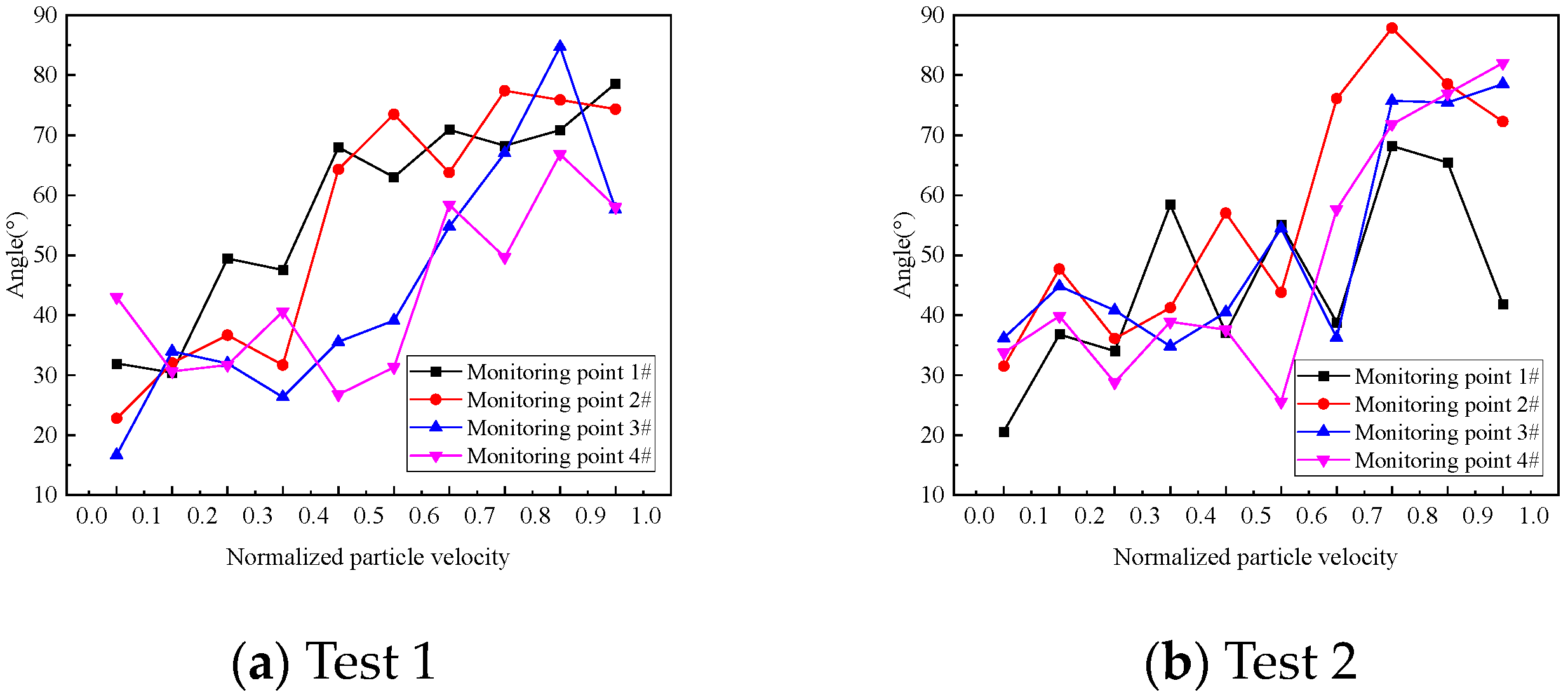
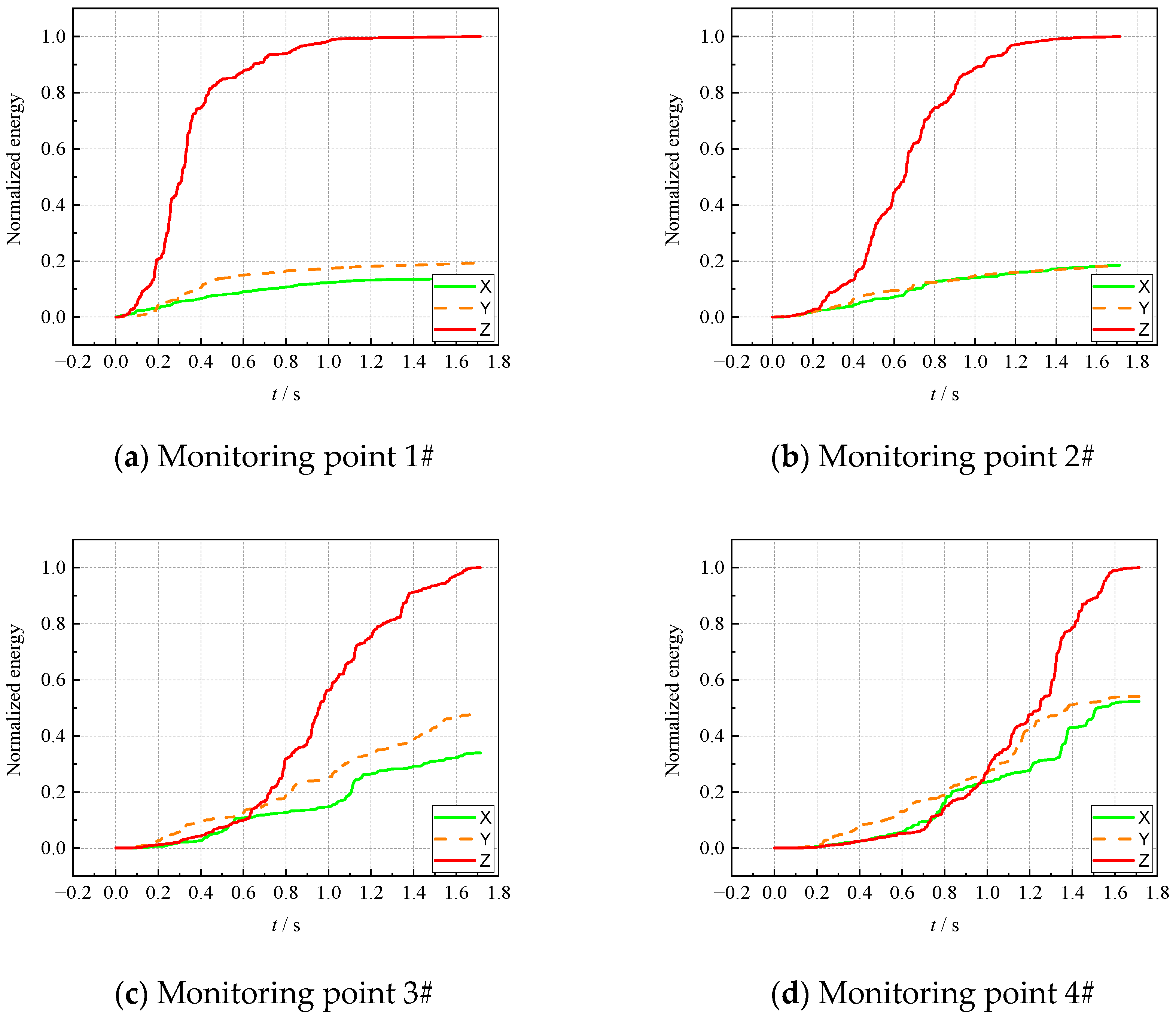
| Test | Monitoring Point | Distance/m | ||
|---|---|---|---|---|
| Lu | Ls | Ld | ||
| 1 | 1# | 193.4 | 48.9 | 354.8 |
| 2# | 301.8 | 54.0 | 256.8 | |
| 3# | 415.3 | 56.6 | 158.4 | |
| 4# | 506.0 | 71.5 | 111.8 | |
| 2 | 1# | 74.1 | 38.9 | 209.8 |
| 2# | 152.1 | 49.7 | 138.8 | |
| 3# | 234.1 | 43.9 | 55.5 | |
| 4# | 249.7 | 49.5 | 57.0 | |
| Velocity Direction | Measurement Point 1# | Measurement Point 2# | Measurement Point 3# | Measurement Point 4# | |||||||||
|---|---|---|---|---|---|---|---|---|---|---|---|---|---|
| a | b | R2 | a | b | R2 | a | b | R2 | a | b | R2 | ||
| Test 1 | X (↗) | −0.007 | 3.911 | 0.444 | −0.015 | 5.841 | 0.846 | −0.012 | 6.081 | 0.875 | −0.019 | 10.743 | 0.937 |
| X (↘) | −0.010 | 3.977 | 0.893 | −0.013 | 4.616 | 0.829 | −0.040 | 7.491 | 0.853 | −0.199 | 23.169 | 0.912 | |
| Y (↗) | −0.036 | 7.831 | 0.863 | −0.022 | 7.895 | 0.909 | −0.009 | 5.613 | 0.791 | −0.014 | 8.954 | 0.865 | |
| Y (↘) | −0.013 | 5.102 | 0.826 | −0.019 | 5.770 | 0.673 | −0.034 | 7.278 | 0.711 | −0.167 | 19.621 | 0.917 | |
| Z (↗) | −0.089 | 19.050 | 0.904 | −0.044 | 14.473 | 0.961 | −0.024 | 10.910 | 0.952 | −0.024 | 12.779 | 0.965 | |
| Z (↘) | −0.035 | 10.546 | 0.779 | −0.056 | 13.480 | 0.893 | −0.077 | 14.289 | 0.804 | −0.272 | 31.797 | 0.942 | |
| Test 2 | X (↗) | −0.210 | 16.455 | 0.733 | −0.105 | 16.341 | 0.927 | −0.043 | 10.652 | 0.935 | −0.041 | 10.464 | 0.862 |
| X (↘) | −0.050 | 10.049 | 0.756 | −0.109 | 14.836 | 0.905 | −0.763 | 41.881 | 0.884 | −1.221 | 70.427 | 0.690 | |
| Y (↗) | −0.233 | 19.695 | 0.450 | −0.074 | 12.661 | 0.757 | −0.035 | 7.604 | 0.655 | −0.037 | 8.784 | 0.762 | |
| Y (↘) | −0.066 | 13.378 | 0.889 | −0.080 | 12.114 | 0.889 | −0.717 | 40.681 | 0.831 | −0.759 | 45.487 | 0.733 | |
| Z (↗) | −0.320 | 27.525 | 0.856 | −0.168 | 26.339 | 0.908 | −0.074 | 17.067 | 0.757 | −0.062 | 15.124 | 0.938 | |
| Z (↘) | −0.086 | 16.885 | 0.888 | −0.183 | 25.146 | 0.796 | −1.735 | 96.905 | 0.786 | −2.097 | 117.475 | 0.844 | |
Disclaimer/Publisher’s Note: The statements, opinions and data contained in all publications are solely those of the individual author(s) and contributor(s) and not of MDPI and/or the editor(s). MDPI and/or the editor(s) disclaim responsibility for any injury to people or property resulting from any ideas, methods, instructions or products referred to in the content. |
© 2023 by the authors. Licensee MDPI, Basel, Switzerland. This article is an open access article distributed under the terms and conditions of the Creative Commons Attribution (CC BY) license (https://creativecommons.org/licenses/by/4.0/).
Share and Cite
Bao, S.; Fei, H.; Hu, G. Characteristics and Energy Distribution of Blast-Induced Ground Vibration in Deep-Hole Blasting. Buildings 2023, 13, 899. https://doi.org/10.3390/buildings13040899
Bao S, Fei H, Hu G. Characteristics and Energy Distribution of Blast-Induced Ground Vibration in Deep-Hole Blasting. Buildings. 2023; 13(4):899. https://doi.org/10.3390/buildings13040899
Chicago/Turabian StyleBao, Shijie, Honglu Fei, and Gang Hu. 2023. "Characteristics and Energy Distribution of Blast-Induced Ground Vibration in Deep-Hole Blasting" Buildings 13, no. 4: 899. https://doi.org/10.3390/buildings13040899
APA StyleBao, S., Fei, H., & Hu, G. (2023). Characteristics and Energy Distribution of Blast-Induced Ground Vibration in Deep-Hole Blasting. Buildings, 13(4), 899. https://doi.org/10.3390/buildings13040899





